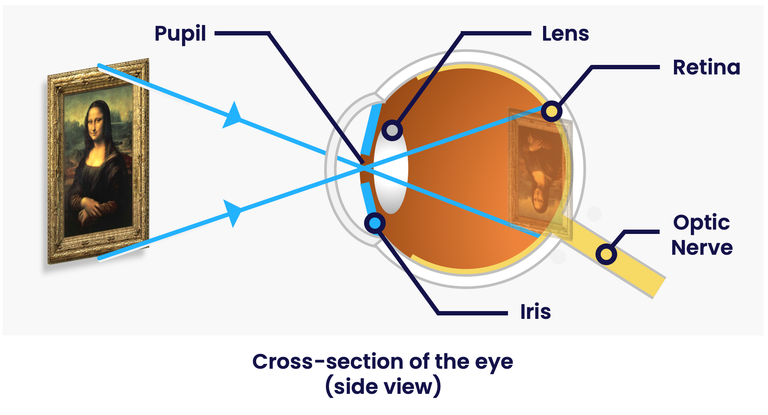Why things are visible?

Because of light. Light reflects off or is emitted by objects and travels to our eyes, where it is processed by the brain to form images. For an object to be visible, it must either be a luminous object, which emits its own light (like a lamp), or a non-luminous object, which reflects ambient light that then enters our eyes.
Light enters through the cornea, which acts like a window at the front of the eye. The amount of light entering the eye is controlled by the pupil, which is surrounded by the iris – the coloured part of the eye. The pupil changes size according to how much light is present; it is smaller in bright light and becomes larger when there is less light.
The cornea bends the light entering the eye to allow more focused images to form on the retina. The retina is a complex part of the eye, and its job is to turn light into signals about images that the brain can understand. Only the very back of the retina is light sensitive: this part is the size of a small coin. It’s packed with photosensitive cells called rods and cones, which help us to see in daytime and at night.
But enough of its structure, the core functioning is that our brain works together with our eyes to process the information we see and transform it into recognisable images. The clear disc-like part of the eye called the lens helps to focus light on the retina. The ciliary muscle adjusts the shape of the lens, helping it to focus on objects at different distances. This automatic focusing is a reflex response and is not controlled by the brain.
Once the image is clearly focused on the sensitive part of the retina, energy in the light that makes up that image creates an electrical signal. Nerve impulses can then carry information about that image to the brain through the optic nerve, which is a collection of more than a million nerve fibres. As the cornea bends light when it enters the eye, the brain receives images that are upside down, so it turns them the right way up when it processes the information.
Also, we can see colours other than red, green and blue because the cones can detect additional wavelengths of light and work together to produce different colours. The brain is able to interpret the signals sent from the cones into colours. It is thought that the human eye can perceive around a million colours, although people whose eyes have a fourth cone can see even more.
So, in summary, vision comes from the mixture of our eyes' interpretation and light coming into them. This is why things are visible, to us that is. For all we know they could not exist at all outside of our vision. Like Pink or Orange don't.
Congratulations @moriame! You have completed the following achievement on the Hive blockchain And have been rewarded with New badge(s)
You can view your badges on your board and compare yourself to others in the Ranking
If you no longer want to receive notifications, reply to this comment with the word
STOP